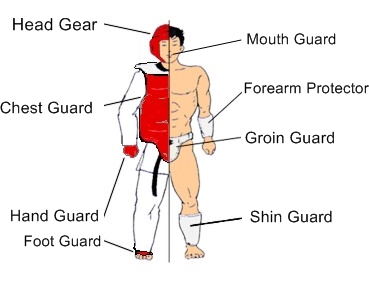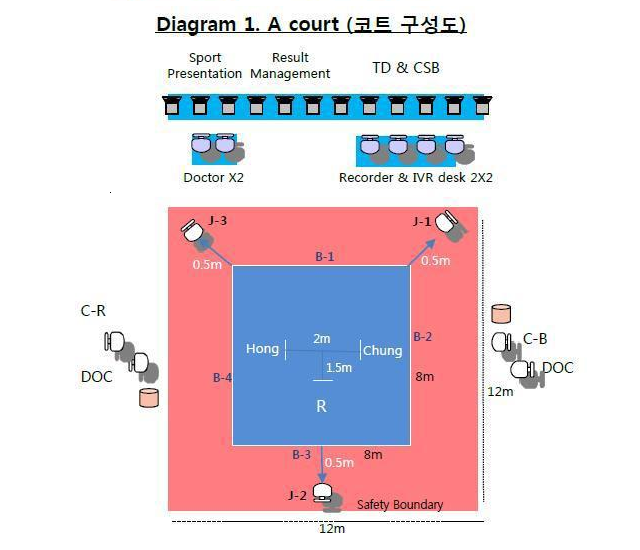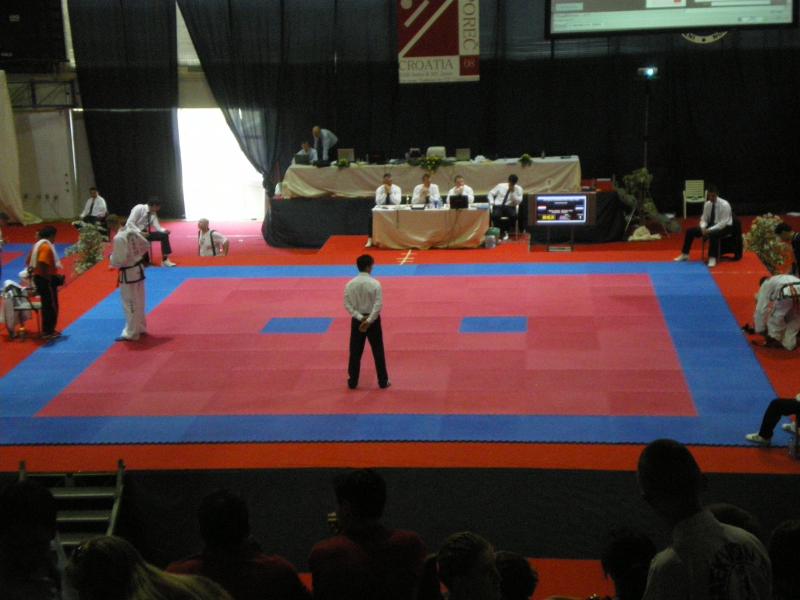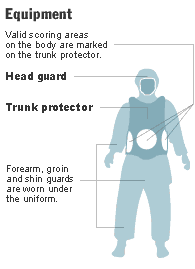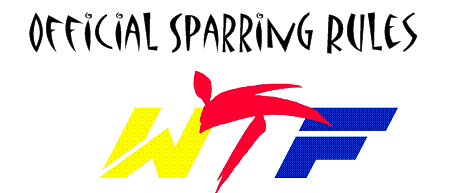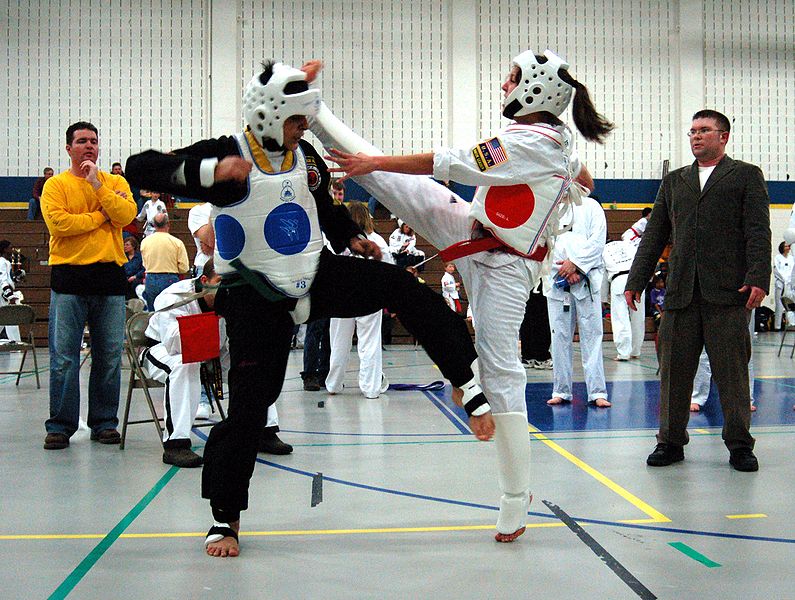
Different schools may observe different sets of rules for a sparring match according to their needs, the ability of the student, and the particular federation or association witch the school is affiliated to.
Here we have posted a “basic” set of rules to follow when sparring. Remember when you visit other schools, to review and understand their rules prior to a match. For an official Olympic and WTF set of rules, read below.
Basic Sparring Rules
- All students are subject to the rules of free sparring and point sparring. Failure to adhere to these rules is cause for dismissal and termination of the match. Absolutely no exceptions are permitted to the sparring rules.
- Sparring is undertaken at students-own risk and in accordance with the terms and conditions of the school membership agreement.
- Approved safety equipment must be used at all times. The following safety equipment is required: Protective footwear, protective hand wear, head guard, shin guards, mouth guard, groin guard (men only), and chest protectors.
- Sparring is allowed only in the presence, and with the permission, of an instructor.
- Sparring is LIGHT CONTACT only. It is important to remember that students are training partners and not opponents. Techniques to the head guard are to be made only with a controlled light tapping, sufficient to indicate a point but insufficient to cause the recipient’s head to move in any way.
- No full-contact sparring will take place under any circumstances.
- Point sparring consists of rounds lasting between one and two minutes , or by the accumulation of five to ten points. Points are awarded in the following manner:
- Controlled valid attack or simple kick to trunk: One point.
- Controlled kick to the body with a turning kick: Two points.
- Controlled kick to the head: Three points.
- Controled turning kick to the head: Four points.
- Free sparring consists of one or a series of rounds performed in a nonstop manner. The purpose of free sparring is to build confidence and improve skills.
- Students will never be forced to spar with anyone. At any time before or during a match or round, students may, without reservation, bow out of the match by indicating to both the training partner and the instructor that you do not care to participate.
Olympic and WTF Taekwondo Rules
Olympic sparring competitions are fought between two “opponents” within the same weight category (to see the WTF list of weights categories click here), in a square shaped, matted area normally made of a high density foam rubber. This Contest Area shall measure 8m x 8m using the metric system. The Contest Area shall have a flat surface without any obstructing projections, and be covered with an elastic and not slippery mat. The Contest Area may also be installed on a platform 0.6-1m high from the base, if necessary. The outer part of the Boundary Line shall be inclined at a gradient of less than 30 degrees, for the safety of the contestants.
Olympic Sparring Zone Layout
Boundary lines: B 1-4; Corner Judges: J-1, J-2, J-3; Center Referee: R; Coach (Red/Hong): C-R; Coach (Blue/Chung): C-B; Team Doctor: DOC; Commission Doctor:Doctor; Instant Video Replay Review Jury: IVR; Technical Delegate & Competition Supervisor Board: TD & CSB.
Taekwondo 2012-04-03_Competition_Rules
Every competitor must wear a standardized head guard, mouth guard, trunk-protector (Hogu), shin guards and wrist guards. Other protection equipment is optional.
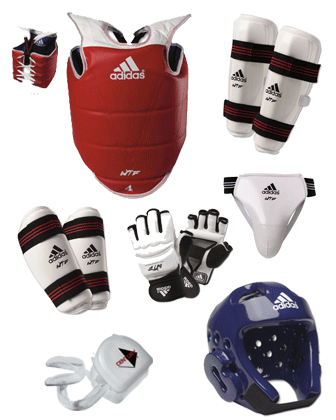
For colored belts (below black belt), each match comprises of three rounds and each round lasts one minute with a 30 second interval between them. Black belt rounds last two minutes with a one minute interval in between. During a round, the action is non-stop and the judges score points according to the strength of the technique, its style and the point of contact. Punches to the head are banned, as are many types of jumping spinning kicks. Attacking below the waist or while a competitor is on the ground is not permitted. Illegal moves result in the perpetrators scores being annulled and can lead to disqualification. According to the new WTF rules, points are award in a 1-2-3-4 point system as follows:
Legal Scoring Areas:
- Body: The blue or red colored area of the body protector.
- Head: The area above the collar bone (i.e. whole part of the head including both ears and the back of the head).
Points shall be awarded when permitted techniques are delivered accurately and powerfully to the legal scoring areas of body and accurately to the legal scoring areas of head. The valid points are divided as follows:
- One (1) point for a valid attack on trunk protector.
- Two (2) points for a valid turning kick to the trunk protector.
- Three (3) points for a valid kick to the head.
- Four (4) points for a valid turning kick to the head.
WTF Competition Rules Interpretation May 11 2015
Click above for a complete set of the official WTF Olympic Taekwondo competition rules interpretation (in force as of 5/11/2015).
Basics
- There will be men’s and women’s competition with four weight classes in each. Weight categories may vary according to each tournament.
- The match consists of three rounds of two minutes each. The rounds are separated by one-minute breaks.
- At least two of the three judges must register a strike in order for the athlete to be awarded points.
- Knockdowns are followed by a 10-count.
Penalties
Three penalty points result in an automatic disqualification.
There are two types of penalties:
- Kyong-go: A warning that counts as a half-point penalty.
- Gam-jeom: A more serious offense that results in a one-point penalty.
Here are some actions contestants can be penalized for:
The score is calculated from all three rounds. If any one competitor achieves a lead of seven points then the match is stopped and he is declared a winner. Likewise, if one Taekwondo competitor reaches twelve points, he is declared the winner. In the event of a three round ‘tie’, a fourth ‘sudden death’ round is fought, after a one minute rest.
You can check an Official WTF Taekwondo Competition Rules video in our video section, for a brief preview of these rules, just click in the link below:
Official WTF Taekwondo Competition Rules Video
Please note that, WTF rules were revised on 2009, some of the old rules where changed or modified. For a complete set of updated rules, please click in the image below.

